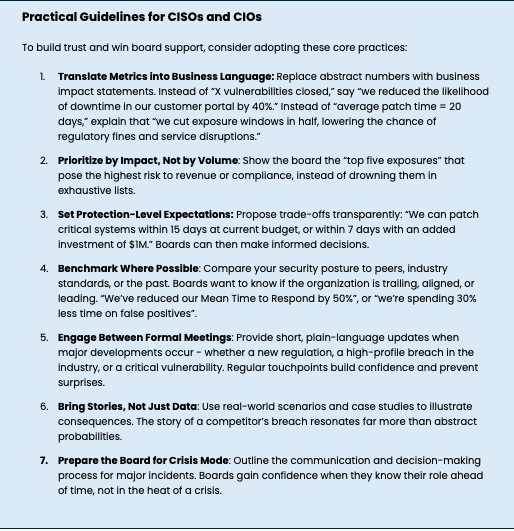
In recent years, cybersecurity has gone from being a specialist concern to one of the most pressing issues in the boardroom. Executives and directors are increasingly expected to understand and oversee cyber risk with the same diligence they apply to financial, operational, and strategic risks. The reason is clear: regulators, investors, and customers hold boards accountable when cyber defenses fail.
Recent regulatory changes make this accountability explicit. The SEC’s cybersecurity disclosure rules require public companies to report how their boards oversee cyber risk. In Europe, the NIS2 directive and the Digital Operational Resilience Act (DORA) establish clear obligations for corporate boards to ensure cybersecurity governance is robust, continuous, and business-aligned. These frameworks do not merely recommend guidelines for oversight - they demand it, attaching personal liability to executives and directors in cases of negligence.
This creates both pressure and opportunity. CISOs and CIOs can either continue to struggle with skeptical boards, or they can turn them into a strong ally by equipping executives and directors with intelligible and actionable insights.
Boards often lack confidence in the information they receive about cyber risk. Dashboards full of vulnerabilities, patch counts, or maturity scores may reflect activity but fail to convey meaning. In many cases, these dashboards are not only perceived as irrelevant but are misleading - suffering from what I call the Watermelon Effect (showing “green” to leadership, while hiding much “red” inside). What boards really need to know is:
Traditional reporting overwhelms, confuses, and creates a trust deficit between CISOs and their boards. Without clear answers, boards are left in the dark. Worse, they may perceive cybersecurity as a money pit rather than as a business enabler.
CISOs and CIOs can change this dynamic by shifting from technical reporting to business-driven reporting. Instead of presenting raw technical data, frame cybersecurity in terms that directly connect to companies’ context. Let’s have a look a few dimensions of this context:
When executive and supervisory boards see risks and defenses through this contextual lens, they can make informed tradeoffs, much as they would when evaluating capital investments or market risks.

Tonic Security empowers CISOs and CIOs to provide boards with exactly the kind of context described above. Our platform continuously correlates exposures, assets, and threats with the business processes they impact - carving the most efficient path to remediation and mitigation. Instead of drowning in technical findings, CISOs can:
• Show which business processes are most at risk.
• Highlight how adversaries could realistically exploit exposures.
• Demonstrate progress over time in reducing risks that matter.
By delivering concise, contextualized insights, Tonic helps security leaders transform board conversations from defensive reporting into strategic decision-making.
Cybersecurity is now a board-level responsibility. Directors must exercise diligence, and CISOs must equip them with the right tools to do so. Framing risk in the organization’s context and business terms - rather than in technical jargon and generic metrics - CISOs can gain the endorsement and resources needed to build resilience and succeed in their jobs. By articulating value in terms of uptime, risk reduced, and potential losses avoided, you help the board see cybersecurity as an investment that protects revenue and reputation – not just a cost center.